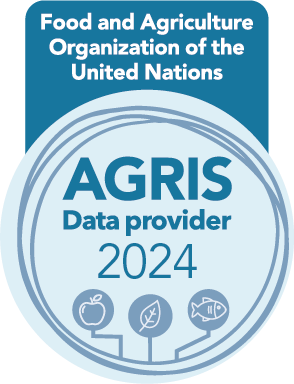A comprehensive study on the stability of Desi cotton (Gossypium arboreum) genotypes under rainfed conditions using AMMI and GGE biplot analysis
DOI:
https://doi.org/10.14719/pst.6432Keywords:
adaptability, genotype × environment interaction, Gossypium arboreum, rainfed, stabilityAbstract
The present study aims to assess the stable and adaptable cotton genotypes under rainfed vertisol conditions using Additive Main effects Multiplicative Interaction and Genotype and Genotype × Environment (GGE) biplot analyses. Seventeen cotton genotypes were evaluated for seed cotton yield at the Agricultural Research Station, Kovilpatti, over three years (2020, 2021 and 2022), treated as distinct environments. Seed cotton yield was subjected to pooled ANOVA, AMMI and GGE biplot analysis, revealing significant variation between genotypes, environment and GEI, with the climate and G × E interaction accounting for 33.8 % and 27.8 % of the total variation, respectively, in seed cotton yield. Based on AMMI I analysis, the genotypes G5 (TKA 0856) and G13 (TKA 1336) were found to have overall adaptability in all the environments (years) studied and considered stable genotypes. GGE biplot was plotted for seed cotton yield using PC1 and PC2, accounting for 70.2% and 26.2 %, respectively, explaining 96.4 % of the total GEI variance. The winning genotypes identified for three mega-environments are G2 (TKA 0612), G16 (TKA 1104) for the first, G6 (TKA 1035), G13 (TKA 1336) for the second and G11 (TKA 1326), G4 (TKA 0848) for the third respectively. The genotype G6 (TKA 1035) was chosen as the most ideal genotype based on mean vs. stability analysis. Among the test environments, E1 was considered the most discriminating environment suitable for selecting widely adapted genotypes.
Downloads
References
Prakash AH, Sabesh M. Contribution of AICRIP on cotton in changing Indian cotton Scenario. Int Cotton Res Asso. 2022;1(11):22–29.
Blaise D, Venugopalan MV, Raju AR. Introduction of Bt-cotton hybrids in India: Did it change the Agronomy? Indian J Agron. 2014;59:1–20. https://doi.org/10.59797/ija.v59i1.4534
Verma SK, Tuteja OP, Monga D, Waghmare VN. GMS-CISG 20 – A new genetic male sterile line of diploid cotton (Gossypium arboreum L.) with marker trait. J Cotton Res Develop. 2020;34:46–49.
Blaise, Kranthi K, Saxena S, Venugopalan M, Mohan P. Productivity and fibre attributes of absorbent Asiatic cotton (Gossypium arboreum) cultivars in rainfed central India. Indian J Agric Sci. 2022;92(3):300. https://doi.org/10.56093/ijas.v92i3.122542
Gauch HG, Zobel RW. Identifying mega-environments and targeting genotypes. Crop Sci. 1997;37:311–26. https://doi.org/10.2135/cropsci1997.0011183X003700020002x
Yan W, Kang MS. GGE biplot analysis: A graphical tool for breeders, geneticists and agronomists. Boca Raton: CRC Press; 2003 https://doi.org/10.1201/9781420040371
Khan MMH, Rafii MY, Ramlee SI, Jusho M, Mamun MA. AMMI and GGE biplot analysis for yield performance and stability assessment of selected Bambara groundnut (Vigna subterranea L. Verdc.) genotypes under the multi-environmental trials (METs). Sci Rep. 2021;11:22791. https://doi.org/10.1038/s41598-021-01411-2
Lee SY, Lee HS, Lee CM, Ha SK, Park HM, Lee SM, et al. Multi-environment trials and stability analysis for yield-related traits of commercial rice cultivars. Agric. 2023;13:256. https://doi.org/10.3390/agriculture13020256
Farias FJC, Carvalho LP, Filho SJL, Teodoro PE. Biplot analysis of phenotypic stability in upland cotton genotypes in Mato Grosso. Genet Mol Res. 2016;15(2):1?10. http://dx.doi.org/10.4238/gmr.15028009
Suinaga FA, Bastos CS, Rangel PLE. Phenotypic adaptability and stability of cotton cultivars in Mato Grosso state, Brazil. Pesq Agropec Trop. 2006;36:145–50.
Baraki F, Zenawi G, Belay Y, Teame G, Zerabruk G, Assefa A, et al. Parametric and non-parametric measures to identify stable and adaptable cotton (Gossypium hirsutum L.) genotypes. J Nat Fibers. 2024;21(1):2317426. https://doi.org/10.1080/15440478.2024.2317426
Samak ANR, Rajeswari S, Ravikesavan R, Subbalakshmi LN, Ganapathy S, Kini AV. Comparison of AMMI and GGE biplot analysis to assess the adaptability and stability of bt cotton genotypes. Int J Curr Microbiol App Sci. 2020;9(9):267–81. https://doi.org/10.20546/ijcmas.2020.909.333
Tinker YWNA. Biplot analysis of multi-environment trial data: principles and applications. Can J Plant Sci. 2006;86:623–45. https://doi.org/10.4141/P05-169
Rakshit S, Ganapathy KN, Gomashe SS, Swapna M, More A, Gadakh SR, et al. GGE biplot analysis of genotype × environment interaction in rabi grain sorghum. [Sorghum bicolor (L.) Moench]. Ind J Genet. 2012;74(4): 558–63. https://doi.org/10.5958/0975- 906.2014.00889.X
Yan W, Kang MS, Ma B, Woods S, Cornelius PL. GGE biplot vs. AMMI analysis of genotype-by environment data. Rev and Interpretation. Crop Sci. 2007;47:643–53. https://doi.org/10.2135/cropsci2006.06.0374
Yang RC, Crossa J, Cornelius PL, Burgueño J. Biplot analysis of genotype × environment interaction: proceed with caution. Crop Sci. 2009;49:1564–76. https://doi.org/10.2135/cropsci2008.11.0665
Hashim N, Rafii MY, Oladosu Y, Ismail MR, Ramli A, Arolu F, Chukwu S. Integrating multivariate and univariate statistical models to investigate genotype-environment interaction of advanced fragrant rice genotypes under rainfed condition. Sustain. 2021;13(8):4555. https://doi.org/10.3390/su13084555

Downloads
Published
Versions
- 18-03-2025 (2)
- 06-03-2025 (1)
How to Cite
Issue
Section
License
Copyright (c) 2025 A Sheeba, P Yogameenakshi, S H Ramakrishnan, N Aanandhi, K Baskar

This work is licensed under a Creative Commons Attribution 4.0 International License.
Copyright and Licence details of published articles
Authors who publish with this journal agree to the following terms:
- Authors retain copyright and grant the journal right of first publication with the work simultaneously licensed under a Creative Commons Attribution License that allows others to share the work with an acknowledgement of the work's authorship and initial publication in this journal.
- Authors are able to enter into separate, additional contractual arrangements for the non-exclusive distribution of the journal's published version of the work (e.g., post it to an institutional repository or publish it in a book), with an acknowledgement of its initial publication in this journal.
Open Access Policy
Plant Science Today is an open access journal. There is no registration required to read any article. All published articles are distributed under the terms of the Creative Commons Attribution License (CC Attribution 4.0), which permits unrestricted use, distribution, and reproduction in any medium, provided the original author and source are credited (https://creativecommons.org/licenses/by/4.0/). Authors are permitted and encouraged to post their work online (e.g., in institutional repositories or on their website) prior to and during the submission process, as it can lead to productive exchanges, as well as earlier and greater citation of published work (See The Effect of Open Access).









